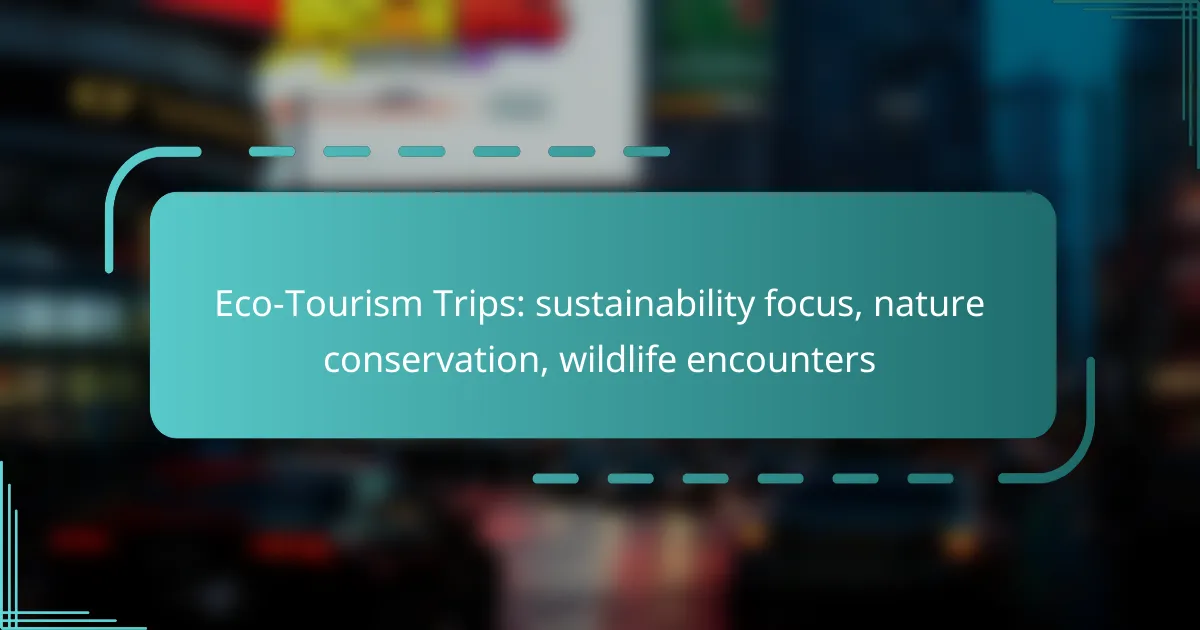Embark on eco-tourism trips that prioritize sustainability and offer unforgettable wildlife encounters in stunning natural settings. From the unique ecosystems of the Galapagos Islands to the vast landscapes of Yellowstone National Park, these journeys not only allow you to observe wildlife in their habitats but also support vital conservation efforts. Experience responsible travel that enriches both your understanding of nature and the well-being of local communities.
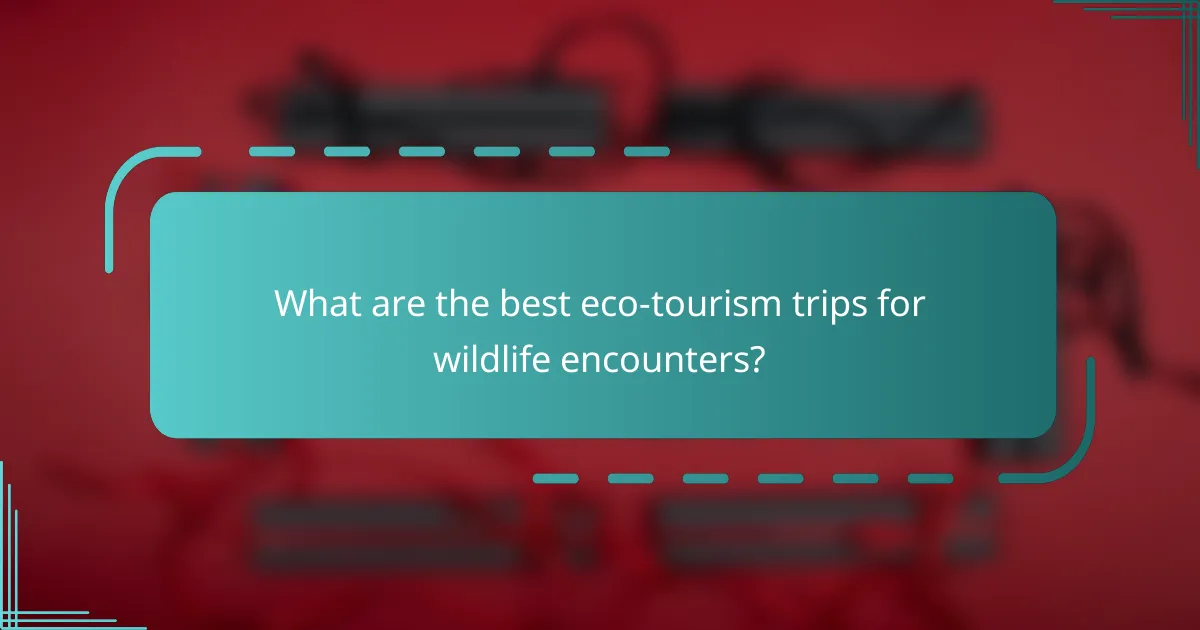
What are the best eco-tourism trips for wildlife encounters?
The best eco-tourism trips for wildlife encounters focus on sustainability while providing immersive experiences in nature. Destinations like the Galapagos Islands, Kenya, the Amazon rainforest, and Yellowstone National Park offer unique opportunities to observe wildlife in their natural habitats while promoting conservation efforts.
Galapagos Islands wildlife tours
Galapagos Islands wildlife tours are renowned for their diverse ecosystems and unique species. Visitors can expect to see giant tortoises, marine iguanas, and various bird species, including the famous blue-footed booby. Tours often include guided hikes and snorkeling, allowing for close encounters with wildlife.
When planning a trip, consider choosing operators that adhere to sustainable practices, such as limiting group sizes and minimizing environmental impact. Prices typically range from a few hundred to several thousand USD, depending on the length and luxury of the tour.
Kenya safari experiences
Kenya safari experiences provide thrilling opportunities to see the “Big Five”—lion, elephant, buffalo, leopard, and rhinoceros—alongside many other species in their natural habitats. Safaris can be conducted in various ways, including game drives, walking safaris, and hot air balloon rides, each offering a unique perspective on wildlife.
Opt for eco-friendly lodges that support local communities and conservation efforts. Costs for a safari can vary widely, generally starting from around 200 USD per day for budget options to over 1,500 USD for luxury experiences.
Amazon rainforest expeditions
Amazon rainforest expeditions immerse travelers in one of the most biodiverse regions on Earth. These trips often include guided hikes, canoeing, and opportunities to spot wildlife such as monkeys, sloths, and countless bird species. Engaging with local indigenous communities can enhance the experience while supporting their conservation efforts.
Choose operators that prioritize eco-tourism and sustainable practices. Prices for Amazon expeditions can range from 100 to 500 USD per day, depending on the level of comfort and inclusivity of activities.
Yellowstone National Park eco-tours
Yellowstone National Park eco-tours offer a chance to explore geothermal features and diverse wildlife, including bison, elk, and wolves. Guided tours often focus on education about the park’s ecosystems and conservation efforts, enhancing the visitor experience.
Consider visiting during the shoulder seasons for fewer crowds and better wildlife viewing opportunities. Tour prices can vary, typically ranging from 50 to 300 USD per person, depending on the type of tour and duration.
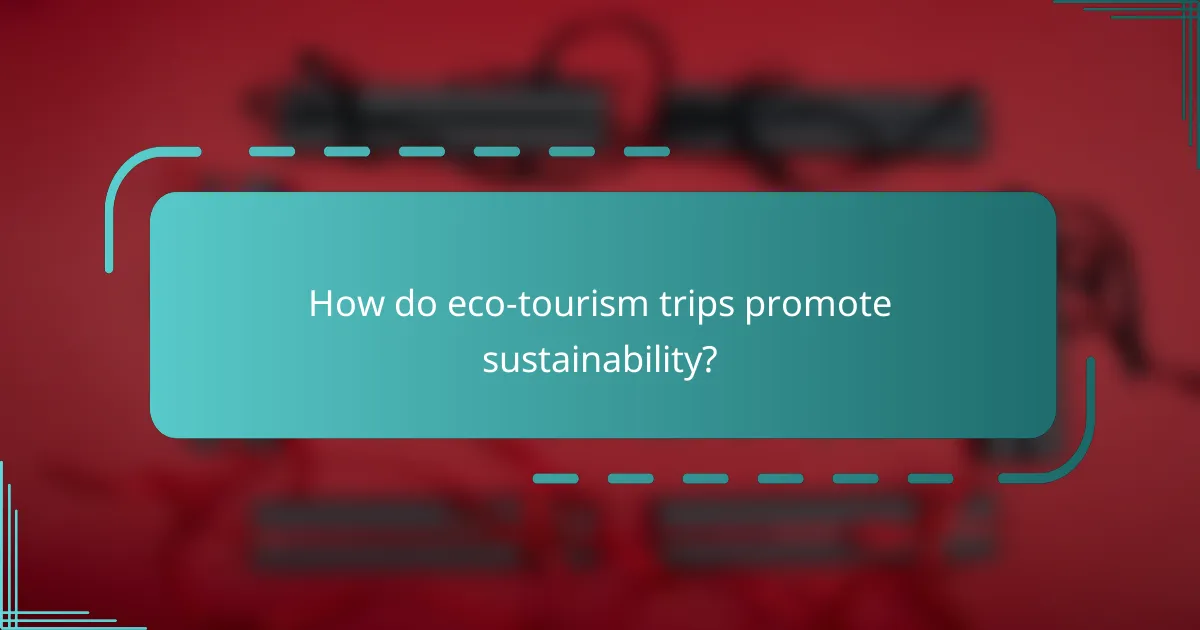
How do eco-tourism trips promote sustainability?
Eco-tourism trips promote sustainability by emphasizing responsible travel practices that benefit the environment and local communities. These trips often focus on minimizing ecological footprints while enhancing awareness and support for conservation efforts.
Support for local communities
Eco-tourism fosters economic growth in local communities by creating jobs and supporting local businesses. Travelers often stay in locally-owned accommodations, eat at local restaurants, and purchase handmade crafts, ensuring that a significant portion of their spending remains within the community.
Additionally, eco-tourism can empower local populations by involving them in decision-making processes regarding tourism development. This engagement helps to ensure that tourism practices align with the community’s needs and values.
Conservation funding through tourism
Many eco-tourism initiatives allocate a portion of their profits directly to conservation projects. This funding can support wildlife protection, habitat restoration, and environmental education programs, creating a sustainable cycle where tourism revenue contributes to preserving natural resources.
For example, some eco-lodges may charge a small conservation fee that goes towards local wildlife reserves. This approach not only aids in conservation efforts but also enhances the travel experience by allowing visitors to witness thriving ecosystems.
Education on environmental issues
Eco-tourism trips often include educational components that raise awareness about environmental challenges and conservation strategies. Guided tours led by knowledgeable locals can provide insights into local ecosystems, wildlife, and sustainable practices.
Travelers can learn about the impact of climate change, biodiversity loss, and habitat destruction, fostering a deeper appreciation for nature. This education empowers tourists to make informed choices and advocate for sustainable practices in their own communities.

What are the top eco-friendly travel companies?
Top eco-friendly travel companies focus on sustainable tourism practices, promoting nature conservation and wildlife encounters. These organizations prioritize minimizing environmental impact while providing enriching travel experiences that benefit local communities.
Intrepid Travel
Intrepid Travel is renowned for its commitment to responsible travel, offering small group adventures that emphasize sustainability. They ensure that their trips support local economies and promote cultural exchange, often partnering with local guides and businesses.
When booking with Intrepid, consider their carbon offset program, which invests in renewable energy projects. Their itineraries often include wildlife encounters that are ethical and respectful of natural habitats, such as visiting national parks or wildlife reserves.
G Adventures
G Adventures is another leader in eco-friendly travel, focusing on community-based tourism. Their trips are designed to have a positive impact on local communities, with a portion of profits reinvested into social projects.
Travelers can expect immersive experiences, such as staying in locally-owned accommodations and engaging in cultural activities. G Adventures also emphasizes animal welfare, ensuring that wildlife encounters are conducted in a responsible manner.
Responsible Travel
Responsible Travel is a platform that connects travelers with sustainable tour operators and eco-friendly accommodations. They curate a selection of trips that prioritize environmental conservation and community engagement, making it easy for travelers to choose responsible options.
When using Responsible Travel, look for their detailed descriptions of each operator’s sustainability practices. This includes information on how trips contribute to conservation efforts and support local economies, helping you make informed choices for your eco-tourism adventures.

How to choose an eco-tourism trip?
Choosing an eco-tourism trip involves evaluating the sustainability practices of the tour operator, understanding the local impact of your visit, and considering the size and style of the group. Prioritizing these factors ensures that your travel contributes positively to nature conservation and wildlife encounters.
Assess sustainability certifications
Look for eco-tourism trips that have recognized sustainability certifications, such as the Global Sustainable Tourism Council (GSTC) or local eco-labels. These certifications indicate that the operator adheres to specific environmental and social standards.
Check if the tour operator participates in programs that promote responsible tourism practices, such as minimizing waste, conserving water, and supporting local communities. A certified operator is more likely to prioritize sustainability in their operations.
Evaluate local impact
Consider how the eco-tourism trip affects the local environment and communities. Research whether the tour supports conservation efforts, such as wildlife protection or habitat restoration, and how it contributes to the local economy.
Engage with operators that provide transparency about their impact. Look for initiatives that involve local guides or benefit local businesses, ensuring that your travel dollars support the community.
Consider group size and tour style
The size of the group can significantly influence the eco-tourism experience. Smaller groups often lead to a more intimate experience with nature and less environmental disruption. Aim for tours that limit group sizes to enhance wildlife encounters and reduce the ecological footprint.
Additionally, evaluate the tour style. Options like hiking, kayaking, or cycling generally have a lower environmental impact compared to larger bus tours. Choose a style that aligns with your values and enhances your connection with the natural surroundings.
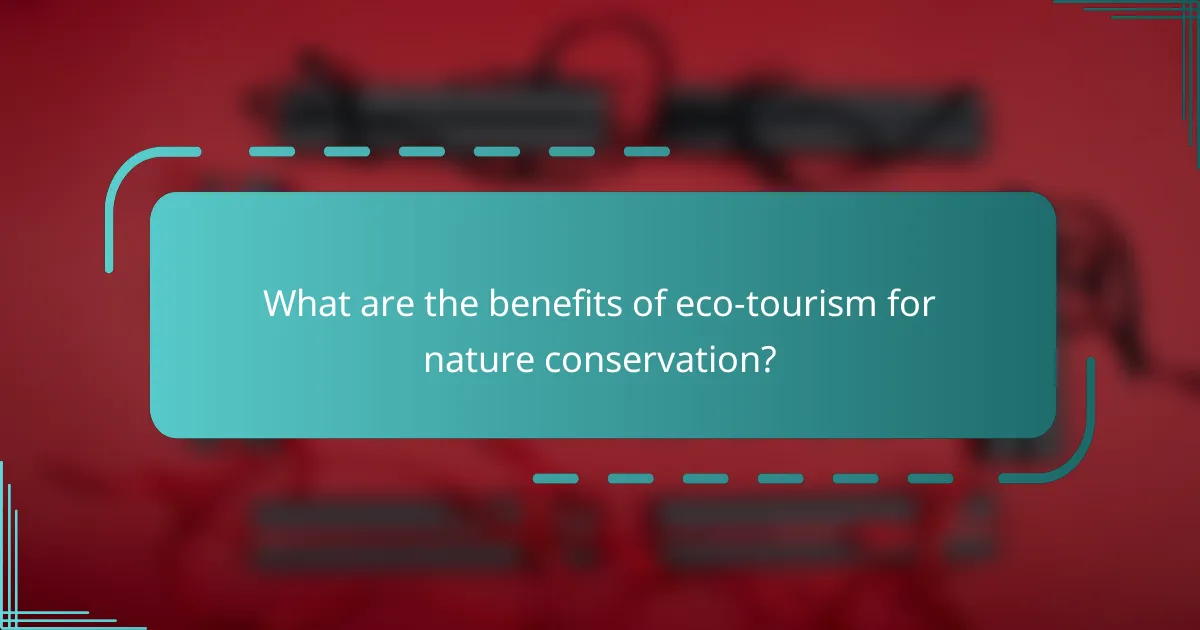
What are the benefits of eco-tourism for nature conservation?
Eco-tourism provides significant benefits for nature conservation by promoting sustainable travel practices that protect ecosystems and wildlife. It encourages travelers to engage with nature responsibly, contributing to conservation efforts and local economies.
Habitat preservation
Eco-tourism plays a crucial role in habitat preservation by generating funding for conservation projects. Tourists often visit protected areas, which helps maintain these habitats and supports the local economy through entrance fees and guided tours.
Additionally, eco-tourism initiatives often involve local communities in conservation efforts, ensuring that they have a vested interest in preserving their natural surroundings. This collaboration can lead to more effective protection of critical habitats.
Wildlife protection initiatives
Many eco-tourism programs are designed specifically to protect endangered species and their habitats. By raising awareness and providing financial support, these initiatives help fund anti-poaching efforts and rehabilitation programs for wildlife.
Travelers can participate in wildlife monitoring and conservation activities, which not only enhances their experience but also contributes directly to the protection of vulnerable species. This hands-on approach fosters a deeper connection to nature and encourages responsible behavior.
Promotion of biodiversity
Eco-tourism promotes biodiversity by encouraging the conservation of diverse ecosystems. Tourists are often drawn to areas with rich flora and fauna, which can lead to increased funding and efforts to protect these environments.
Moreover, eco-tourism can help educate visitors about the importance of biodiversity and the threats it faces. This awareness can inspire travelers to advocate for conservation efforts long after their trip, creating a ripple effect that benefits ecosystems globally.
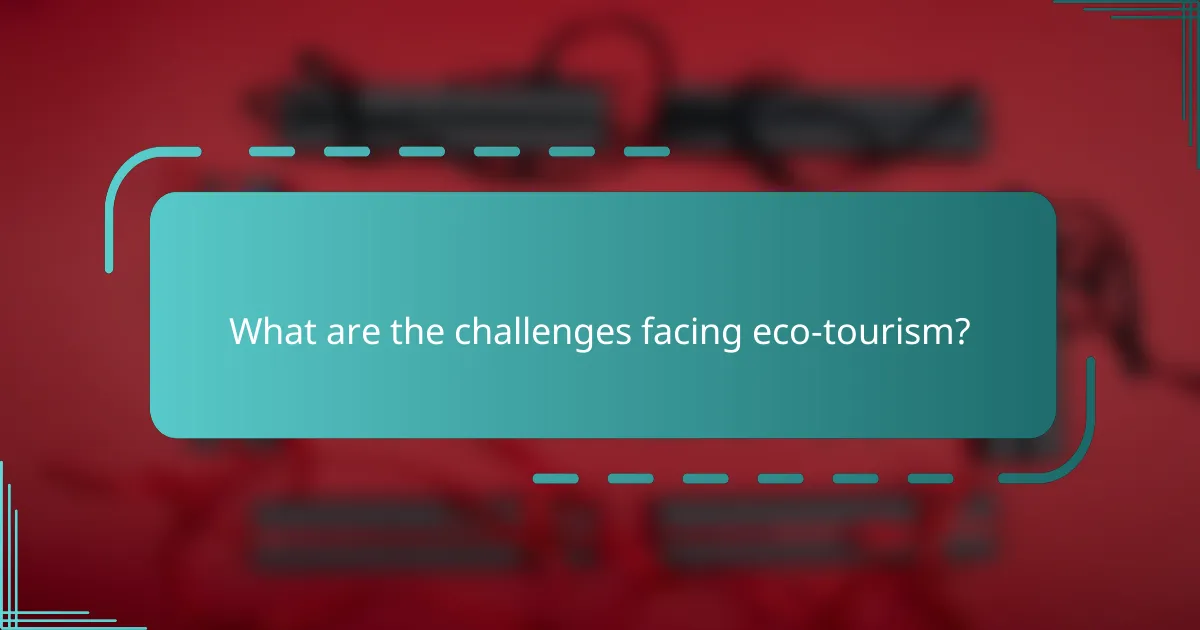
What are the challenges facing eco-tourism?
Eco-tourism faces several challenges that can undermine its sustainability and conservation goals. Key issues include environmental degradation, cultural impacts, and economic pressures that can lead to exploitation rather than preservation.
Environmental Impact
Despite its focus on sustainability, eco-tourism can still contribute to environmental degradation. Increased foot traffic in sensitive areas can lead to soil erosion, habitat destruction, and pollution. Tour operators must carefully manage visitor numbers and activities to minimize these impacts.
To mitigate environmental harm, eco-tourism operators should adhere to best practices such as limiting group sizes, using eco-friendly transportation, and promoting Leave No Trace principles. Regular assessments of the ecological footprint can help identify areas for improvement.
Cultural Sensitivity
Eco-tourism often involves interactions with local communities, which can lead to cultural misunderstandings or exploitation. Tourists may inadvertently disrespect local customs or traditions, leading to tension between visitors and residents. It is crucial for operators to educate travelers about cultural norms and practices.
Engaging local communities in the planning and management of eco-tourism initiatives can foster respect and mutual benefit. This collaboration ensures that tourism supports local culture rather than undermines it, creating a more authentic experience for visitors.
Economic Viability
Eco-tourism must balance profitability with its commitment to sustainability. Economic pressures can lead operators to prioritize short-term gains over long-term environmental and social goals. This can result in practices that harm ecosystems or local communities.
To ensure economic viability, eco-tourism businesses should focus on sustainable practices that attract conscientious travelers. Offering unique experiences, such as guided nature walks or wildlife conservation projects, can enhance appeal while supporting conservation efforts.
